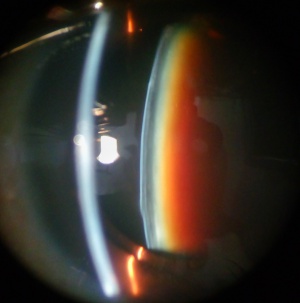Black Cataract
All content on Eyewiki is protected by copyright law and the Terms of Service. This content may not be reproduced, copied, or put into any artificial intelligence program, including large language and generative AI models, without permission from the Academy.
Black Cataract
A cataract is a clouding of the eye’s lens that may progress to blindness if left uncorrected by surgery. Other sections of eyewiki discuss types of cataracts including hardening of the nucleus known as nuclear sclerosis, opacification of the outer cortical layers, posterior subcapsular, immature, mature, hypermature, morgagnian, congenital, lamellar, polar and sutural cataracts. The various worldwide grading systems for Cataracts are designed to correlate the amount of opacification of both the center of the lens and the back surface of the lens to the percentage of visual area obstructed. Black Cataract is not addressed in those systems and not adequately discussed elsewhere.
Black cataract is very specific. The lens nucleus has become so hardened, sclerotic and blackened that it has gone beyond what is known as brunescence. Brunescence is a discoloration of the nucleus that occurs as the nucleus becomes sclerotic. Brunescence begins as a yellowing and progresses to orange and brown. With the progressive discoloration and opacification, the vision gradually diminishes over time.
Black cataract causes legal blindness meaning the vision is expected to be Hand Motion or Light Perception and not much better. This presents serious and anticipated risks for planning surgery. With a diagnosis of Black Cataract, the preferred surgical procedure may be a planned Extracapsular Cataract Extraction. In certain centers, with advanced Laser technology, laser cracking of the lens would be advised prior to phacoemulsification. With a Black Cataract, increased ultrasonic time and energy are needed to liquefy the denseness of the blackened lens. As such, the patient is at risk for posterior capsular tears, zonular tears and other surgical complications. The surgeon must be adequately trained to anticipate and manage the surgical risks attendant with removal of a Black Cataract.
In India, untreated Glaucoma has the misnomer of Black Cataract when the damage has caused optic atrophy and irreversible blindness.
References:
- CDC http://www.cdc.gov/visionhealth/basic_information/eye_disorders.htm
- http://www.ncbi.nlm.nih.gov/pubmed/2610158 Nippon Ganka Gakkai Zasshi. 1989 Jul;93(7):796-800.
- http://www.ncbi.nlm.nih.gov/pubmed/2071351 Invest Ophthalmol Vis Sci. 1991 Jul;32(8):2400-3. The effect of cataract severity and morphology on the reliability of the Lens Opacities Classification System II (LOCS II). Maraini G, Pasquini P, Sperduto RD, Bonacini M, Carrieri MP, Corona R, Graziosi P, Tomba MC, Williams SL.
- http://www.jcrsjournal.org/article/S0886-3350(02)01839-4/abstract Clinical Applications of the lens opacities classification system III in the performance of phacoemulsification Presented at the symposium on Cataract, IOL and Refractive Surgery, San Diego, CA April 2011 James A Davison MD, Leo T Chylack Jr MD
- http://www.ncbi.nlm.nih.gov/pubmed/11709249 J Cataract Refract Surg. 2001 Nov;27(11):1762-9. Phacoemulsification of brunescent and black cataracts. Singh R(1), Vasavada AR, Janaswamy G.
- http://doctor.ndtv.com/faq/ndtv/fid/5023/What_is_black_cataract.html



